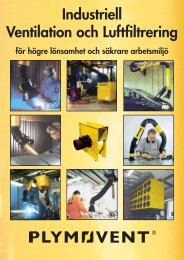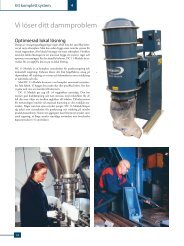instruktion user instruction Betriebsanleitung gebruikers handleiding
instruktion user instruction Betriebsanleitung gebruikers handleiding
instruktion user instruction Betriebsanleitung gebruikers handleiding
Create successful ePaper yourself
Turn your PDF publications into a flip-book with our unique Google optimized e-Paper software.
Test Running<br />
1. Verify that the power is locked out. Inspect<br />
the belt tension (Figure B next page),<br />
rotate the pump and listen for any sound<br />
indicating worn bearings or misaligned<br />
impellers. Check that the inlet and outlet<br />
are properly connected. Also check that the<br />
vacuum relief valve is connected.<br />
2. Mount the covering panels. Check that no<br />
persons can be hurt if the pump starts and<br />
that all outlets are closed.<br />
3. Connect a manometer for negative pressure<br />
calibrated to min. -50 kPa to the suction<br />
side as close to the pump as possible.<br />
4. Power up the pump and listen carefully for<br />
the following sounds; A high pitch whine is<br />
normal sound from the impeller blades. As<br />
pump draws cooling air from the vacuum<br />
relief valve a weak hissing should be heard.<br />
5. Measure the pressure. Compare with the<br />
dimension point. The pressure can be<br />
adjusted by adjustment of the vacuum relief<br />
valve. See page 23 - Adjusting the vacuum<br />
relief valve.<br />
6. Check the function and tightness of the<br />
connected exhaust system.<br />
7. Open the number of outlets the system is<br />
dimensioned for. The vacuum relief valve<br />
should now be totally closed.<br />
8. It is normal that the pump becomes hot<br />
during operation.<br />
TPR 40, 15 kW - 21 Art nr 9045<br />
ENGLISH








